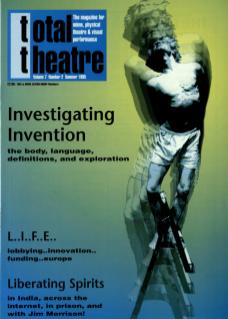Think of the piece as a spatial track. Watching Optik is to see the lines and rectangles of Mondrian, the blocks and space of Newman brought into three dimensions. A spatial text of rhythm, movement and pace where choice is played out within transparent rules. A free, focused traversing of space between any two points fixed by each of the three performers. Choice and changes of direction are forced by the rule of avoiding collision with people or objects. No colluding with the spectators who are confronted yet invited into the narrative; spectator as the acknowledged and the ignored.
Think of the piece as an aural track. A background of percussive sound fitting the movement by chance and synchronicity. The sound of feet as the performers run, trot, walk, pounding the floor in their rhythms. The sound of their breathing as it rises and falls, straining with effort.
Think of the piece as a visual track. The spectators watch the performers – they watch each other at the same time. Our faces are the backdrop against which the patterns are played out. Sheets of free-standing perspex become a terminal point in the traverse. The framing as the performers pass to and fro in the street, past the windows, in and out of the space. The images and patterns being traced on the balcony, through the window, across the floor. We see the percussionist as the fourth performer as he creates a soundscape to match the movement around him.
Think of the piece as an audit track. The formal line between spectator and performer becomes blurred as the piece is watched and absorbed. We find ourselves looking at each other. But the line remains nevertheless, those who sit as audience will always be auditing those who pace the floor. However fragile, however fluid the division or boundary between roles these remain distinct to the Nth degree. We participate by sitting in and creating the performance space as auditors: we read and interpret the images presented. We have no control over those images: we are not empowered as 'spect-actors' but they are our images woven in our minds out of shared energy.
Think then of the piece as a multi-track creation of ‘energy sites', images and patterns formed by the watcher and watched out of the tracks as these combine, permute and entwine. Always shifting as our perspectives and perceptions shift. Here process and product are not hierarchies and chronologies but a loop of ongoing exchange. Moments of frisson as rigour and the erotic collide. Not a story but a narrative formed out of the collaborations: between tracks, being watched and watchers, between process and performance.

